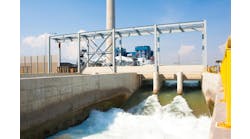Poster sessions at virtually all wastewater conferences these days include papers on breakthroughs in wastewater remediation based on applications of nanotechnology. The environmental benefits offered by this new technology have inspired considerable enthusiasm.
Nanotechnology broadly refers to the use of materials and structures with dimensions of less than 100 nm. While nanotechnology is about size, it also is about how things are put together, arranged and assembled. When certain materials are smaller than 100 nm, they take on unique properties. For example, materials that previously did not conduct electricity may now do so, ones that might have displayed a color might now be invisible, and insoluble materials might now be soluble.
The federal government strongly backs development of nanotechnology, seeking to ensure that the United States leads the way in developing and commercializing appropriate applications. There is no better evidence of the Administration’s support than the December 2003 passage of The 21st Century Nanotechnology Research and Development Act, which authorizes $3.7 billion in federal support for nanotechnology, authorizes and funds the National Nanotechnology Initiative (NNI), creates various centers to coordinate and promote research, and sets national goals and benchmarks for progress to achieve them.
The areas of pollution prevention, remediation and detection hold particular promise for nanotechnology. The U.S. Environmental Protection Agency (EPA) certainly is well aware of the potential. Through its Science to Achieve Results (STAR) grant program, EPA funds approximately $6 million in academic research to study this emerging technology.
EPA is also aware of potential risks posed by nanoscale materials. On May 10, the agency issued a Federal Register notice announcing the scheduling of a public meeting this month to consider and discuss a potential voluntary pilot program for existing nanoscale materials under the Toxic Substances Control Act (TSCA). This pilot program would seek information on nanoscale versions of existing chemical substances that might be marketed. The regulation of such materials under TSCA and in the context of a voluntary pilot program are hotly debated and EPA can expect to hear many different views expressed on this topic.
Nanotechnology for wastewater
There can be no doubt that water preservation and usage are among the very highest priorities for EPA and for stakeholders generally concerned with sustainability and environmental protection. The Bush Administration has expressed strong support for continuing research on nanotechnology for, among other reasons, the extraordinary promise it holds for environmental protection, with wastewater remediation a likely beneficiary. Here are just a few illustrations of the applications of nanotechnology in this area:
Fullerenes as pollution tracers— EPA is supporting fullerenes research to evaluate the likelihood of contaminants reaching aquifers and to provide contaminant-fate information to assist in developing remediation strategies. Fullerenes, also known as C60 or buckey balls, are nonpolar molecules composed of pure carbon. They are well suited to serve as tracers because they dissolve readily in many organic solvents and can easily be modified by the addition of different functional groups to match the reactivity and solubility of the contaminant of interest. According to EPA’s National Center for Environmental Research, fullerenes are believed to be nontoxic. The only health effect associated with them is an inhalation risk, one that is unlikely to arise in this application.
Nanoporous ceramic— Researchers at the Pacific Northwest National Laboratory, Richland, Wash., are experimenting with a chemically modified nanoporous ceramic that can remove contaminants from waste streams. Called a nanosponge, this SAAMS (self-assembled monolayers on mesoporous supports) material could be used in environmental applications such as drinking water purification, wastewater treatment and site remediation.
In the future, wastewater remediation technologies likely will differ significantly from those now used. The opportunities for innovation are limitless and readers are urged to stay on top of the many potential environmental applications of nanotechnology.
